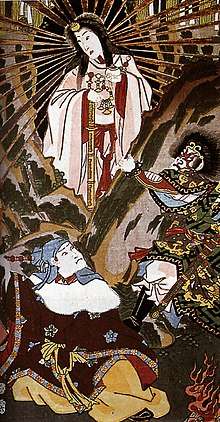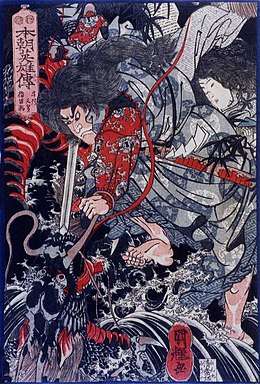Tennin
Tennin (天人), which may include tenshi (天使), ten no tsukai (天の使い, lit. heavenly messenger), hiten (飛天, lit. flying heaven) and the specifically female tennyo (天女) are spiritual beings found in Japanese Buddhism that are similar to western angels, nymphs or fairies. They were seemingly imported from Chinese Buddhism,[1] which was itself influenced by the concepts of heavenly beings found in Indian Buddhism and Chinese Taoism.
.jpg)
History
Tennin are mentioned in Buddhist sutras, and these descriptions form the basis for depictions of the beings in Japanese art, sculpture, and theater. They are usually pictured as unnaturally beautiful women dressed in ornate, colorful kimonos (traditionally in five colors), exquisite jewelry, and flowing scarves that wrap loosely around their bodies. They usually carry lotus blossoms as a symbol of enlightenment or play musical instruments such as the biwa, or flute.[2][3]
Religion
Tennin are believed to live in the Buddhist heaven as the companions to the Buddhas and Bodhisattvas. Some legends also make certain tennin solitary creatures living on mountain peaks. Pilgrims sometimes climb these mountains in order to meet the holy spirits.
Powers
Tennin can fly, a fact generally indicated in art by their colored or feathered kimonos, called hagoromo (羽衣, lit. feather dress).[1] In some legends, tennin are unable to fly without these kimonos (and thus cannot return to heaven).[4] More rarely, they are shown with feathered wings.[2] In a Noh play Hagoromo, which bears a number of similarities to the Western swan maiden legends,[5] tennyo come to the earth and take off their hagoromo. A fisherman spies them and hides their clothes in order to force one to marry him. After some years he tells his wife what he did, and she finds her clothes and returns to heaven.[4] The legend says it occurred on the beach of Miho no Matsubara, now a part of the city of Shizuoka.
See also
| Look up tennin, tennyo, or tenshi in Wiktionary, the free dictionary. |
- Apsara
- Angel
- Nymph
- Divine Being
- Ceres, Celestial Legend
- InuYasha Movie 2: Castle Beyond the Looking Glass
References
- An Overview of Japanese Folklore Archived 2009-07-12 at the Wayback Machine at the Mukashibanashi Library Archived 2006-12-13 at the Wayback Machine
- Tennin at GODS of Japan, A-to-Z Photo Dictionary of Japanese Buddhism (Buddhist & Shinto Deities)
- Hearn, Lafcadio, Glimpses of an Unfamiliar Japan at Project Gutenberg online book catalog
- Waley, Arthur (1921), The Noh Plays of Japan, Chapter V, p. 177, "A Note on Hagoromo"
- The Legend of Connor O'Quin and the Swan Maiden at Folklore of the Burren


